By Laura Rybicki, Curatorial Intern in American Painting and SculptureMarguerite Zorach (American, 1887–1968), in reference to her thoughtfully handmade embroideries, reflected, “These works are built out of my life and the things that have touched my life. . . . In each...
By Laura Rybicki, Curatorial Intern in American Painting and Sculpture
Marguerite Zorach (American, 1887–1968), in reference to her thoughtfully handmade embroideries, reflected, “These works are built out of my life and the things that have touched my life. . . . In each case, there was no restriction. . . . I was absolutely free to do whatever I wished to do.”[1] The Family (In Memory of a Summer in the White Mountains), created in 1917 and newly on view at the Cleveland Museum of Art, displays Zorach’s characteristically free and expressive artistic practice (fig. 1). The embroidery’s central roundel depicts a pregnant Marguerite, her husband, William (a Cleveland-raised sculptor), and their two-year-old son, Tessim, surrounding an evergreen tree; the outer corners feature stylized animal pairings. In this work, Zorach expresses both her love for her family and her appreciation for natural wonder.
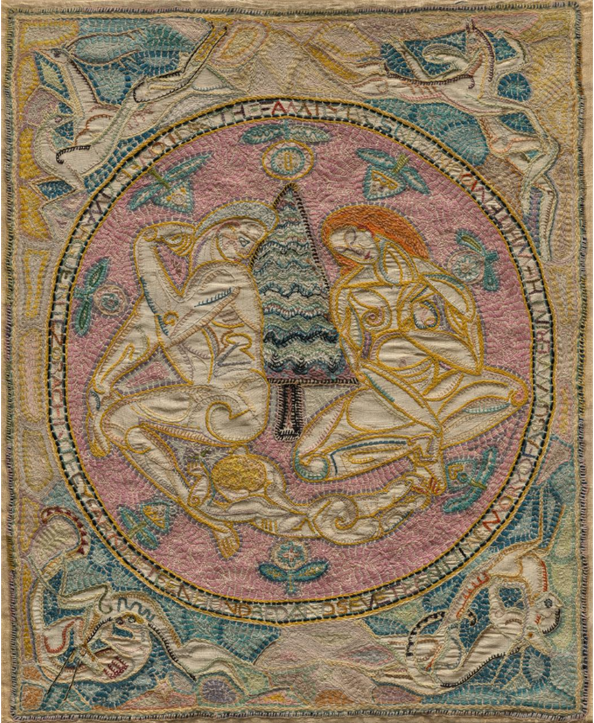 Figure 1. The Family (In Memory of a Summer in the White Mountains), 1917. Marguerite Zorach (American, 1887–1968). Silk: plain weave; wool: embroidery; 86.4 x 72.4 cm. The Cleveland Museum of Art, Edwin R. and Harriet Pelton Perkins Memorial Fund, 2020.261
Figure 1. The Family (In Memory of a Summer in the White Mountains), 1917. Marguerite Zorach (American, 1887–1968). Silk: plain weave; wool: embroidery; 86.4 x 72.4 cm. The Cleveland Museum of Art, Edwin R. and Harriet Pelton Perkins Memorial Fund, 2020.261Although her embroideries are her most celebrated artworks, Zorach considered herself primarily a painter.[2] From 1908 to 1911, she studied in Paris, where she was enchanted by the work of the Fauves, a group of artists who favored expression through vivid colors over realistic representation. After her time in France, she gained an appreciation for vibrant patterned textiles as she traveled through Northern Africa and Asia.[3] She returned to the United States with plenty of inspiration, and her practice flourished.
Zorach began creating embroideries during the 1910s after the birth of her first child, because she found painting to require too much attention for long periods of time; embroideries could be set down and picked up at her leisure.[4] But more than the convenience, Zorach was attracted to the textile medium because of the brightness and variety of color that could be achieved with dyed wool yarn.[5] She later reflected:
I had been to India, and I was trying to put on canvas the brightness and richness of color in an Indian wedding procession. I was so exasperated with the limitations of paint that I bought some wool yarn and started to paint my picture with a needle on a piece of linen. My husband became so fascinated that he too got a needle and we both stitched, hardly stopping to eat. It was exciting.[6]In many cases, Zorach even dyed the wool yarn herself to achieve the ideal color for her works.[7] Although The Family is more than 100 years old, her love of vibrant color still clearly comes across today.
Embroideries and other traditionally feminine artistic media have commonly been relegated to the category of “craft” or “decorative arts,” while painting and sculpture have generally been considered “fine art.” Zorach frequently fought the notion that her embroideries did not belong to the latter category. Indeed, she regularly exhibited them alongside her paintings and considered them to be equal in importance and quality.[8]
Critics and patrons agreed. In 1930, one critic noted that Zorach had achieved “the complete and inseparable fusion of art and craft.”[9] Her prominent patrons, who included the likes of the Rockefeller family, flocked to get their hands on her custom embroideries.[10]
The Cleveland Museum of Art is one of only five public collections in the world to own an embroidery by Zorach.[11] The Family commemorates the Zorachs’ 1917 vacation in New Hampshire, where Marguerite, along with her husband and son, awaited the birth of her daughter, Dahlov.[12] The wording rendered in multicolored wool yarn around the central roundel reads: “THE FAMILY?—?DONE BY MARGUERITE ZORACH IN THE YEAR NINETEEN HUNDRED AND SEVENTEEN IN MEMORY OF A SUMMER IN THE WHITE MOUNTAINS” (fig. 2). The image that appears on the embroidery became a kind of family crest, appearing on their Christmas cards (fig. 3).
 Figure 2. Detail of The Family (In Memory of a Summer in the White Mountains)
Figure 2. Detail of The Family (In Memory of a Summer in the White Mountains)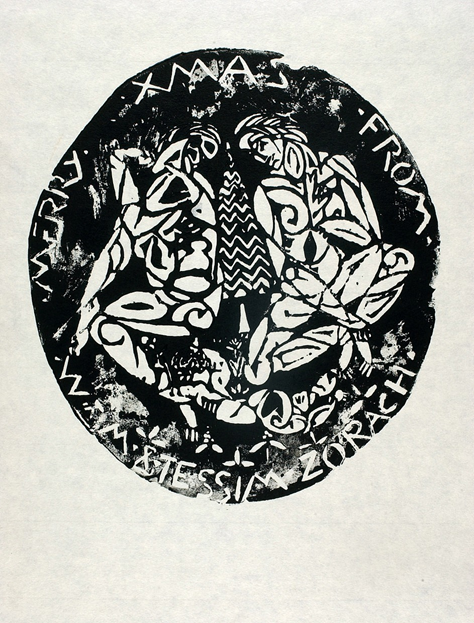 Figure 3. Merry Xmas from W and M and Tessim Zorach, c. 1915. Marguerite Zorach and William Zorach (Lithuanian, 1887–1966). Linoleum cut on paper; diam. 21 cm. Smithsonian American Art Museum, Gift of Dahlov Ipcar and Tessim Zorach, 1968.154.760
Figure 3. Merry Xmas from W and M and Tessim Zorach, c. 1915. Marguerite Zorach and William Zorach (Lithuanian, 1887–1966). Linoleum cut on paper; diam. 21 cm. Smithsonian American Art Museum, Gift of Dahlov Ipcar and Tessim Zorach, 1968.154.760The design is rather fitting for a Christmas card because it directly references traditional Nativity and Holy Family imagery commonly found in Renaissance paintings, such as The Holy Family with Saint John the Baptist and Saint Margaret by Filippino Lippi (fig. 4). By likening her family to a modern Holy Family, she highlights the spiritual glory of motherhood and expresses her devotion to her loved ones.
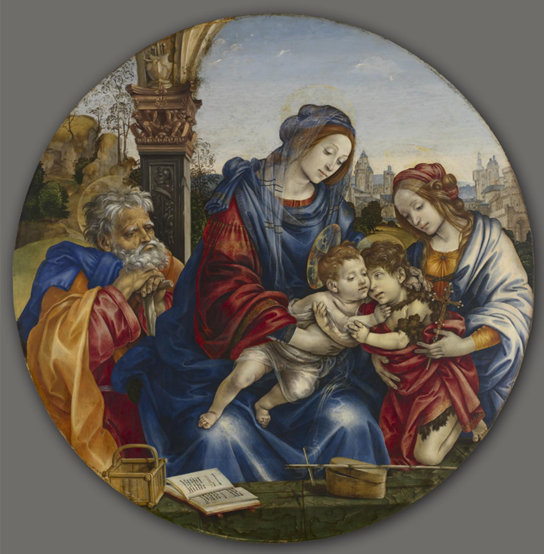 Figure 4. The Holy Family with Saint John the Baptist and Saint Margaret, c. 1495. Filippino Lippi (Italian, 1457–1504). Tempera and oil on wood; framed: 184 x 186 x 9.5 cm; diam. 153 cm. The Cleveland Museum of Art, The Delia E. Holden Fund and a fund donated as a memorial to Mrs. Holden by her children: Guerden S. Holden, Delia Holden White, Roberta Holden Bole, Emery Holden Greenough, Gertrude Holden McGinley, 1932.227
Figure 4. The Holy Family with Saint John the Baptist and Saint Margaret, c. 1495. Filippino Lippi (Italian, 1457–1504). Tempera and oil on wood; framed: 184 x 186 x 9.5 cm; diam. 153 cm. The Cleveland Museum of Art, The Delia E. Holden Fund and a fund donated as a memorial to Mrs. Holden by her children: Guerden S. Holden, Delia Holden White, Roberta Holden Bole, Emery Holden Greenough, Gertrude Holden McGinley, 1932.227The embroidery’s outer corners are populated by pairs of various creatures, including gazelles, deer, cheetahs, and one female human figure. The upper two pairs coexist in peace, frolicking playfully through the abstract landscape, while the lower two pairs engage in fierce battles. With these groups, Zorach seems to signify the duality of nature, a force at once nurturing and threatening, simultaneously peaceful and hostile. Certainly, these contradictions were at the forefront of her mind as a protective mother taking her child into the wilderness.
Zorach’s technique is unusual, combining traditional embroidery stitches with her own expressive inventions. In relation to her technique, she once commented that she used “all manner of stitches according to the immediate need of expression.”[13] Much of the background is covered in swirling running stitches that create an abstract area for the figures to inhabit (fig. 5). Additionally, she combined different stitches to create texture, a technique exemplified in the evergreen tree, which involved layering blue, green, brown, and black yarn in a variety of stitches (fig. 6). Her unique stitching technique can be likened to a painter’s distinctive brushstroke.
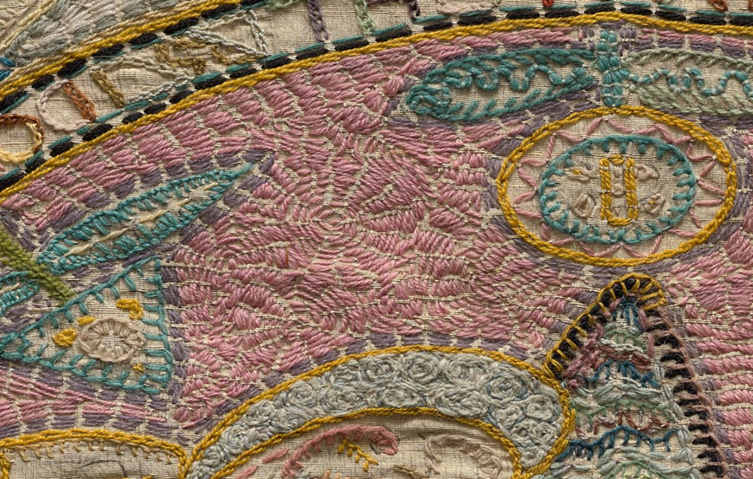 Figure 5. Detail of The Family (In Memory of a Summer in the White Mountains)
Figure 5. Detail of The Family (In Memory of a Summer in the White Mountains)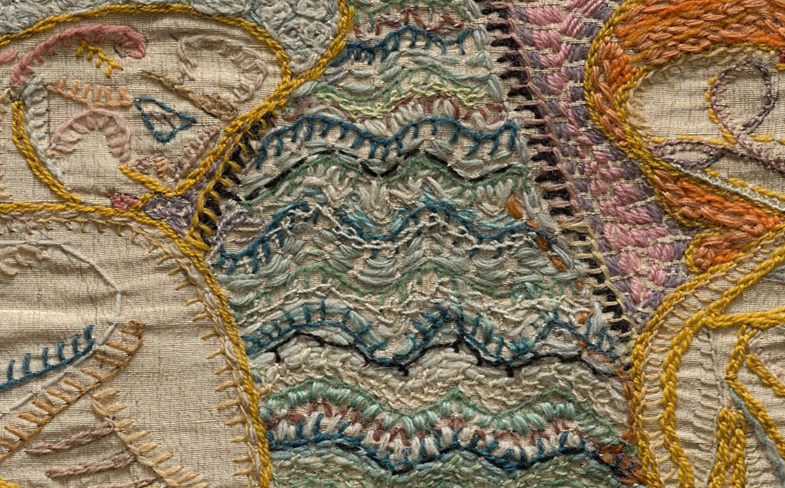 Figure 6. Detail of The Family (In Memory of a Summer in the White Mountains)
Figure 6. Detail of The Family (In Memory of a Summer in the White Mountains)Marguerite Zorach’s stunningly unconventional but nevertheless intentionally designed embroideries defy traditional characterization as “decorative art” or “craft.” Her works have prompted critics to question the craft / fine art dichotomy altogether. Zorach’s will to express herself through art never ceased despite the limitations that she faced as a busy mother. In fact, the flexibility and diverse colors afforded by textiles only enhanced her creativity, resulting in a small but acclaimed and impactful artistic output, which rivals the work of the great modernist sculptors and painters. The Family (In Memory of a Summer in the White Mountains), and Zorach’s work as a whole, tells the story of a woman who was committed to both her family and her passions and who refused to let her artistry be devalued.
[1] “The Tapestries of Marguerite Zorach,” Design 38, no. 2 (1937): 3.
[2] “The Tapestries of Marguerite Zorach,” 3.
[3] “Zorach, Marguerite,” Benezit Dictionary of Artists, October 31, 2011, https://www.oxfordartonline.com/benezit/display/10.1093/benz/9780199773787.001.0001/acref-9780199773787-e-00202380?rskey=WrmuY0&result=2.
[4] “Mothers’ Medium,” Time, November 4, 1935, https://content.time.com/time/subscriber/article/0,33009,755278,00.html.
[5] Marguerite Zorach, “Embroidery as Art,” Art in America (Fall 1956): 51.
[6] Marguerite Zorach, “A Painter Turns Craftsman,” Craft Horizons 4 (February 1945): 2.
[7] “Mothers’ Medium.”
[8] Hazel Clark, “The Textile Art of Marguerite Zorach,” Woman’s Art Journal 16, no. 1 (Spring–Summer 1995): 22.
[9] Marya Mannes, “The Embroideries of Marguerite Zorach,” International Studio 95 (March 1930): 29.
[10] Rebecca Shaykin, Edith Halpert: The Downtown Gallery and the Rise of American Art, exh. cat. (New York: Jewish Museum; New Haven: Yale University Press, 2019), 69.
[11] In addition to the Cleveland Museum of Art, Zorach’s embroideries can be found in the collections of the Metropolitan Museum of Art; Museum of Fine Arts, Boston; Smithsonian American Art Museum; and Cooper Hewitt, Smithsonian Design Museum.
[12] Roberta Tarbell, Marguerite Zorach: The Early Years, 1908–1920, exh. cat. (Washington, DC: Smithsonian Institute Press, 1973): 50.
[13] Zorach, “Embroidery as Art,” 66.
New on View: Marguerite Zorach’s The Family (In Memory of a Summer in the White Mountains) was originally published in CMA Thinker on Medium, where people are continuing the conversation by highlighting and responding to this story.







